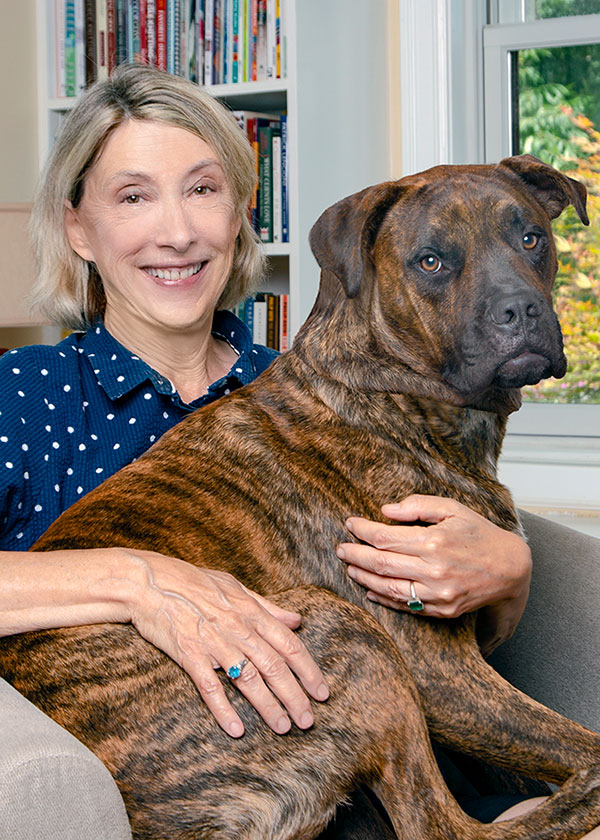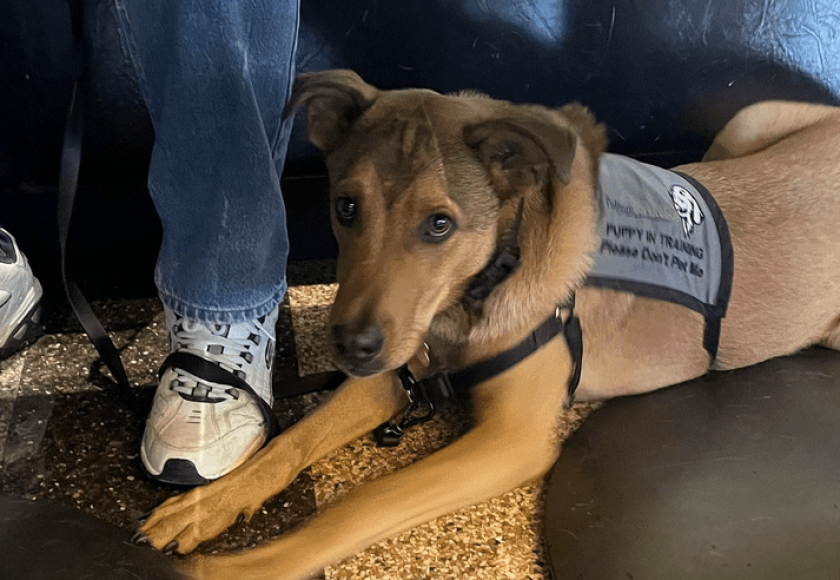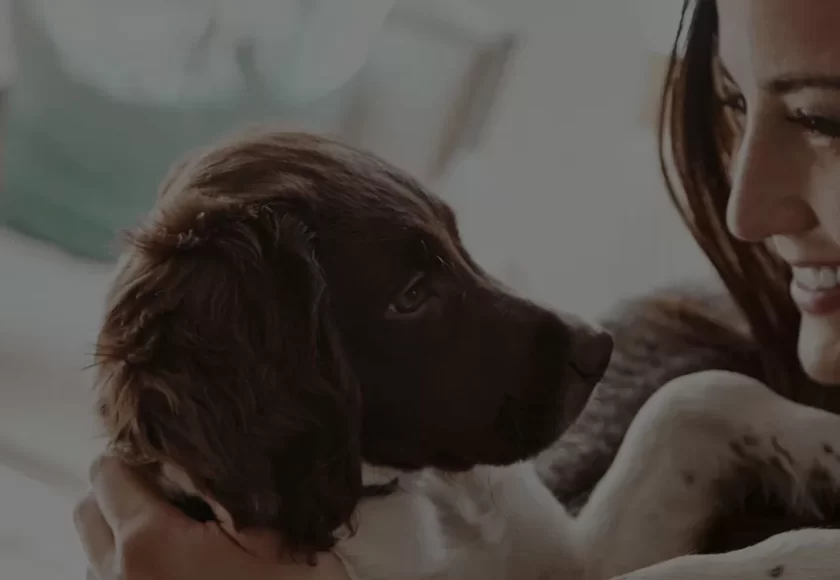Crate training a puppy—especially a future service dog—is one of the most valuable tools our volunteer puppy raisers can use. A crate offers a calm, secure space where a puppy can rest, reset, and learn to self-soothe. Service dogs have to be comfortable in small spaces – under a restaurant table, in an airplane or bus, etc, so the crate acclimates the pup to being safe, happy and OK in a small space. Whether you’re heading to a vet appointment, traveling, or simply helping your pup settle into a daily routine, the crate becomes a place of comfort and familiarity. It’s also essential for house training and teaching good rest habits—two important building blocks for a successful service dog.
At Putnam Service Dogs, we work closely with our puppy raisers to ensure crate training is done with care, consistency, and compassion. It’s not just about getting a puppy to tolerate a crate—it’s about helping them feel safe and confident in their own space. That confidence carries through into adulthood, making our dogs more adaptable in public, more relaxed at home, and more resilient in the face of new experiences.
What Is Crate Training?
Crate training is the gradual process of helping a puppy accept and feel comfortable in a crate. When done properly, a crate becomes a calm, cozy space where a dog can rest, regroup, and feel secure. The earlier a puppy is introduced to the crate, the more natural and beneficial it becomes throughout their life—and especially in their journey as a service dog. We feed our dogs in their crates so they associate their crate with good things happening to them there. As soon as they’re no longer chewing/destroying beds, they’re given a soft crate pad or bed to make the crate a great napping place. And always a chew toy – something for them to do in the crate. We make sure to rotate the toy in their crate so they’re not bored with the crate.
Why Crate Training Matters for Service Dogs
Crate training supports essential qualities we nurture in every Putnam Service Dog: patience, independence, adaptability, and confidence. Here are a few key benefits:
House Training Help
Dogs instinctively avoid soiling their sleeping space. A properly sized crate supports consistent house training by teaching the puppy to hold it until they’re taken outside. We regularly take them out so they learn humans will reliably meet their need to go out, and holding it is worth the effort. If they cry/indicate they have an issue, we let them out of the crate to take them outside to eliminate immediately, rather than adhere to a set schedule. Humans have to show the pup they are reliable.
Anxiety Reduction
When introduced positively, the crate becomes a safe retreat. The crate should not be used as a place of punishment. We may give our dogs time out in their crate (like small children get time out), but we never put the pup in the crate when we’re angry. It’s a calm, “Kennel”, even when the pup has done something they shouldn’t. If the crate is used as a Time Out for the pup, it helps the pup learn to settle themselves when overstimulated—an invaluable trait for service dogs who must remain calm in busy environments.
Better Sleep Habits
Crates help puppies learn when it’s time to rest. Encouraging naps in the crate after play, meals, or potty time creates a reliable rhythm for both you and your pup.
Safer Travel and Emergencies
A crate-trained dog travels more calmly if you use the crate in your car, and can handle vet visits, grooming appointments, and emergency evacuations with less stress.
Fewer Destructive Behaviors
If left unsupervised, puppies may chew, scratch, or get into trouble. Crates offer a safe place to rest or chew their toy when you’re not able to watch them closely.
Recovery After Illness or Injury
If your puppy ever needs medical care or surgery, a crate-trained pup will recover more comfortably and with less stress when confined for rest.
Independence & Confidence
Service dogs need to be self-reliant. Time in the crate helps puppies develop the ability to comfort themselves and feel secure even when alone.
How to Properly Crate Train a Puppy: Tips and Tricks
Before diving into the crate training process, there are a few things to keep in mind. First, make sure the crate you are using is the correct size for the puppy. The puppy should be able to stand up all the way, stretch out all the way, and turn a full 360 degrees without bumping into the sides or top of the crate. Second, make sure at least one or two approved chew toys are in the crate with the puppy to help him or her feel at home.
Here are a few proven strategies we recommend to all our volunteer puppy raisers:
Play the Crate Game
Start with a game to make the crate fun! Toss a piece of kibble inside and when the pup goes in, mark with “Good boy!” or “Good girl!” and offer another few pieces between the front paws. Repeat often to build positive associations.
Feed Meals in the Crate
Serve meals inside the crate—ideally in a Kong or slow-feeder bowl. In the beginning, let the puppy out as soon as they’re finished. Over time, allow them to rest quietly inside the crate post-meal.
Build a Daily Nap Routine
After a short walk, playtime, a meal, and a potty break, your pup is naturally ready to rest. Guide them into the crate for naptime as part of a regular routine.
Add Toys and Chews
Approved chew toys in the crate keep your puppy busy and comfortable. You can also toss toys into the crate to encourage your pup to explore it on their own.
Never Use a Crate for Punishment
The crate should be used only as a positive dog training tool. Puppies should never be put in a crate for punishment, but they can be used as a sort of “time-out” for you or your puppy if you need a break. Make sure to give the puppy a safe chew toy and reward him or her for entering the crate with a “Good boy/girl!” and a treat or piece of kibble.
What Does a Crate-Trained Puppy Look Like?
At Putnam Service Dogs, we aim for our puppies to do four things that show successful crate training:
- Willingly enter the crate on cue (“Kennel”).
- Settle calmly inside the crate without fussing or whining.
- Wait patiently for the door to open—without barking or pawing.
- Exit only when given a release cue, like “Okay.”
This level of self-regulation takes time, but with consistency, care, and support, you’ll get there.
Final Thoughts About Crate Training for Puppy Raisers
Crate training is one of the most effective ways to raise confident, well-adjusted puppies who are ready for the important work ahead. It’s not about containment—it’s about providing a calm, consistent environment where future service dogs can thrive.
We’re deeply grateful to our dedicated volunteer puppy raisers. Your commitment, patience, and love are what make our mission possible. If you’d like to be part of a life-changing journey and help raise a service dog for a veteran or individual with a disability (other than blindness), consider becoming a puppy raiser with Putnam Service Dogs.
FAQs About Crate Training a Puppy
How do I know if my puppy is properly crate trained?
When puppies are properly crate trained, they do four things: willingly enter the kennel on cue, settle easily, remain calm until the door opens, and leave the crate only with a verbal cue.
Is crate training necessary for service dog puppies?
Yes. Service dog pups must learn to trust their human caretakers, self-soothe, and feel confident in their own abilities. Crate training is an important step in this process.
When is the best time to train a puppy to enter the crate during the day?
The best time is after the puppy walks, plays, eats, and goes to the potty. After these things are accomplished, pups will naturally be ready for a nap. Encourage your puppy to enter the crate using hand signals and verbal cues, then reward the puppy for entering.
How long can my puppy stay in the crate at once?
Puppies have small bladders and limited ability to hold it. A general rule of thumb is one hour per month of age, plus one hour. For example, a 3-month-old puppy should not be crated more than 4 hours at a time during the day. Less time is ideal as you don’t want to push the limits of a dog’s ability to hold it. Overnight is usually longer but may require bathroom breaks when the pup is young, or you first get the pup and it isn’t house trained yet.. Crating a grown, house trained dog longer than 6 hours during the day is something we avoid. The dog needs a bigger life than this, more mental stimulation and fun, and a chance to relieve itself. Overnight, if it’s a mature dog, it can be crated for up to 12 hours as it’s metabolism slows down for its nighttime sleep.
What if my puppy cries or whines in the crate?
It’s normal for puppies to protest at first. Check if they need to potty or if the crate is uncomfortable. If they are just seeking attention, avoid letting them out while crying as it can reinforce the behavior. Instead, wait for calm before releasing.
How do I make the crate less scary for my puppy?
Use positive associations like treats, toys, and meals inside the crate. Never force the puppy in. Throw 3-4 pieces of kibble onto the floor of the crate near the back to lure the pup on its own into the crate. Be patient and start with very short stays, gradually increasing the time.
Should I leave the crate door open or closed when I’m home?
When you’re home and supervising, it’s fine to leave the door open so the puppy can explore the crate freely. Closed-door crate time is best for naps, training, or when you need the puppy confined for safety.
What size crate should I use as my puppy grows?
Use a crate with a divider or adjustable panels to ensure the space is just right for your puppy’s current size. Too big and they might use one side or the end as a bathroom. Too small and they won’t be comfortable and it won’t be a positive experience.
Can I use the crate if my puppy has separation anxiety?
Crates can help reduce anxiety if introduced slowly and positively, but if your puppy shows signs of severe separation anxiety, please contact your puppy raising coordinator or trainer for additional guidance.
How do I teach my puppy to enter the crate on cue?
Use a consistent verbal cue like “Kennel” paired with treats and praise. Start by tossing treats inside and encouraging the pup to enter. Reward often until the puppy goes on command.
What if my puppy refuses to go into the crate?
Don’t force the puppy. Go back to basics: make the crate inviting with food, toys, and calm encouragement. Try short sessions and be patient—positive reinforcement is key.






